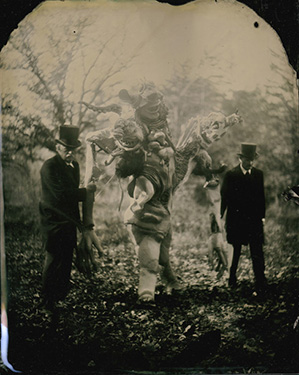


When I landed my first job after grad school and unpacked in my new university office, I came across an old roll of silver tape. Every art historian used to have one, and the really dedicated scholars probably owned a loupe too. The tape was expensive, but it was a must-have for making slides, our discipline's lost art. The whole matter of handling these fragile images was a grad student's rite of passage, typically carried out in the harried days before a big presentation. When we needed slides for illustrated lectures on, say, "J.S. Copley's Portraits of British Loyalists" or "Optics and Neo-impressionism'" we proceeded to the slide library where we parsed the tight rows of little glass squares growing pink from baking under the projector bulbs. The old card catalogue cabinets that warehoused them should have raised our suspicions that this was a format on its way out. But in our rush to find what we were looking for, we never noticed.
The process went like this: When you finally unearthed the slides you wanted (maybe under Africa/Ghana/Pottery or Germany/Dada/ Heartfield?) from among the thousands, you spread the specimens out on a light table and physically worked the miniature copies into a sequenced visual argument. (Monet next to Seurat. First Vlaminck, then Picasso.) More often than not, the linchpin proved elusive (Who had made off with all the Arcimboldos?) and you had to shoot any missing images yourself from art history books using the cheap 35mm camera and rickety copy stand stored in the backroom. The process of making a reproduction from a reproduction left its traces in the new image; curving book seams, errant captions, and stray fingertips were to be expected, but they had to be covered up after the slide was developed and mounted. Masking slides isolated the illustrated objects; the opaque segments of silver tape blocked out the remains of the copying process so there was nothing to disturb the artwork's aesthetic. The application was tedious, like framing a tiny painting, but if you did it correctly the silver edging removed the evidence of your labor so that only the artist's work remained. When you finally presented your lecture, with pride in your flawless slides, your aim was to fade away behind the brilliance of the images and the argument. Only you knew what was hidden under that silver tape.
In October 2004, the Kodak corporation announced it would stop making slide carousels and projectors. Even though digital applications were already finding a toehold in the discipline, that news hit me with a sudden blow. What would happen to all those glass images and all the people who so diligently filed them away? Why had I wasted any time or money making slides? In the course of a year or two, the century-old technology behind the illustrated art history slideshow, the backbone of the discipline, became utterly obsolete. Decommissioned slide projectors, cold and dark in the back of university classrooms, witnessed the installation of new digital video projectors that could be turned on with a single button from a convenient hand-held remote. It never mattered much to me when cassettes gave way to CDs or when DVDs rendered VHS tapes a thing of the past – that was all just for entertainment – but it unnerved me that, at the moment my career was just beginning, a fundamental aspect of my training, all those hours spent wrangling slides, had already become obsolete. It wasn't that I couldn't adapt. It was the shock that a skill you thought set you apart was disappearing before your eyes – the surprise of becoming a beginner when you thought you were an expert. Yes, a few scholars resisted, mostly in the name of image quality or out of mere habit, but it was obviously futile to dig in your heels. And, frankly, when I stopped to think about it, in many ways the new technology made more sense. Digital images and their delivery systems generated presentations that basically looked the same as the old slideshows, their functionalities were as superior to slides, light tables, and carousels, and, most important, they were faster, more portable, more flexible, and more reliable. Occasionally a PowerPoint malfunctioned or a computer crashed, but that was nothing compared to the fury evoked when you failed to lock the carousel's ring and watched eighty well-ordered slides, and with them all your careful effort, spill out onto the floor.
The fact that the switch from analog to digital technology in our classrooms went unnoticed by the students out there in the dark was just one more clever masking job we accomplished. Besides, hadn't it always been about creating illusions? The birth of the illustrated art history presentation, and consequently the birth of the modern discipline, took place over 100 years ago and surprisingly very little changed about the format in the course of those years. Mixing the authority of the nineteenth-century scientific slide lecture, where images operated as visual evidence, with the pleasures of the era's popular lantern slide entertainments in which light and shadow transmogrified into miraculous spectral forms, art history slideshows in universities and museums carried their audiences neither to the realm of pure objectivity nor to that of the supernatural. Instead, late nineteenth-century scholars like Hermann Grimm, an early art historian at Berlin University and one of the first to give slide presentations, sought something beyond science or entertainment; he attempted to evoke the rarified realm of the aesthetic, deeply felt before an actual work of art, in the space of the classroom. The drama of Grimm's powerful lectures proved highly influential and the form became standard: the disembodied voice of the professor, standing in the shadows beyond the projector's glare, conjures each artwork to life, a power wrought with slides and light and screen and words. The luminous phantom image on the screen "becomes" the work of art itself, animated by the professor's vivid description and analysis. When done properly, when the slides are free of lingering fingertips, when the words are pointed and eloquent, when the classroom is just dark enough – for a hour or so everything falls away but the art. If art historians can be said to have any sort of prestige or power, it must come from our ability to make you feel as if you are standing in the presence of an original even as we recognize it all for what it really is: miniature photographs locked in glass or grids of pixels processed by machines.
In the shift to digital technology, little about the experience of the art history lecture has changed for the audience, but a number of illusions have dissipated for me. The process of working with the materials, tools, and machines required by old-fashioned slideshows offered a kind physical labor that wasn't an everyday part of the discipline; it was the material manifestation of the invisible intellectual work that took up most of my time. Making slides also gave me a certain connection to the artistic practices I studied. I always felt a twinge when someone with new knowledge of my occupation asked, "yes, but do you make any art yourself?" As trivial as it sounds, my handiwork in the slide library late at night felt like a parallel to the work of artist colleagues who spent their evenings down the hall in their studios. The particular techniques for handling slides and dealing with projectors were also a specialized knowledge that set me apart from my students and, I admit, gave me a sense of being in command. At one time, I was the only one in the room who knew how to load the carousels correctly or manage the projector. Today, I am as mystified by the true nature of the digital technologies I regularly use, just as nineteenth-century audiences were no doubt flummoxed by the apparitions of light that appeared on the screens before them. My students, those so-called "digital natives," no doubt understand it all much better than I do. And, when I look out into the dark classroom and see the glints of light from their own little screens, their computers, tablets, and phones flashing image after image, I wonder when I will finally disappear completely.

